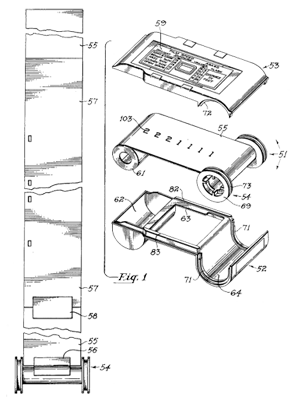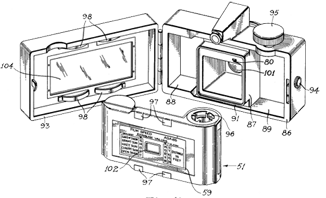|
Braun Paxette 28F |
Manufactured or assembled in Germany from 1965 to 1968.
Index of rarity in France: Infrequent (among non-specialized garage sales)
Inventory number: 6487
See the complete technical specifications
Chronology of cameras Braun
 Although the company existed as an optician since 1915, it wasn't until 1948 that Braun (Karl Braun AG or Carl Braun) started selling cameras. The initial models were fairly simple box cameras. The construction of some boxes was outsourced to Linden, a metallurgical company. Throughout the 1950s, the number of camera models built by Braun increased. The box camera range was quickly complemented by a series of folding cameras with technical levels dating back to pre-war times. The 35mm cameras from the Paxette series found success for almost two decades. However, facing competition from Asia in the 1960s, the company soon ceased this activity to refocus on the production of slide projectors, with the popular Paximat series since 1955. The company became Braun Photo Technik GmbH in the early 2000s. As of 2023, the company still exists and manufactures binoculars and action cameras.
Although the company existed as an optician since 1915, it wasn't until 1948 that Braun (Karl Braun AG or Carl Braun) started selling cameras. The initial models were fairly simple box cameras. The construction of some boxes was outsourced to Linden, a metallurgical company. Throughout the 1950s, the number of camera models built by Braun increased. The box camera range was quickly complemented by a series of folding cameras with technical levels dating back to pre-war times. The 35mm cameras from the Paxette series found success for almost two decades. However, facing competition from Asia in the 1960s, the company soon ceased this activity to refocus on the production of slide projectors, with the popular Paximat series since 1955. The company became Braun Photo Technik GmbH in the early 2000s. As of 2023, the company still exists and manufactures binoculars and action cameras.
This company, based in Nuremberg, has no connection with the household appliance company (Braun AG, later Braun GmbH), founded in 1921. The confusion between the two companies arises from the fact that Braun GmbH also built slide projectors (such as the Braun D7).
The main series of Braun cameras were :
| Box | Box 6x6 or 6x9 |
| Norca | Folding 6x6 and/or 6x9 on film 120 |
| Gloriette | Compact film 135 |
| Paxina | Compact 6x6 on film 120 |
| Paxette | Compact film 135 |
| Paxette 28 | Compact film 126 |
| Paxette 35 | Compact film 135 |
The Paxette 28 is named as such because its lens has an aperture of f/2.8. These cameras have a rectangular design that breaks away from Braun's previous styles. They use 126 film and are also found under other distributor brands.
Despite sharing the name with the Paxette series from the 1950s, these cameras have nothing in common with them.
| Non-exhaustive list | Lens | Shutter | Flash | Light meter | |
| Paxette 28 | Braun Color-Paxon 2.8/38 mm |
Prontor 125 | Shoe | No | |
| Paxette 28 B | Braun Color-Paxon 2.8/38 mm |
Prontor 125 | Shoe | Selenium | |
| Paxette 28 BC | Rodenstock Trinar 2.8/38 mm |
Compur | Shoe | Selenium | |
| Paxette 28 F | Steinheil Color-Paxon 2.8/38 mm | Prontor 125 | AG-1 | Fausse | |
| Paxette 28 LK | Schneider-Kreuznach Xenar 2.8/38 mm | Compur | Shoe | Selenium | |
This camera is built around the "Instamatic" cartridge. It allows for adjusting the aperture and time. The speed range is a bit limited (1/30, 1/60, 1/125, and a B setting).
The aperture settings are accompanied by meteorological symbols. Similarly, the distance ring is supplemented with icons for portrait, group, and landscape.
No hasty enthusiasm at the sight of the selenium cell on the front: it is fake. However, the camera is equipped with a built-in flash. A reflector and a protective glass can be unfolded on the left side, revealing a socket for a magnesium bulb. The flash is powered by a small battery housed to the left of the film access door.

Film and 126 Camera
 The patent 3,138,081 was published on June 23, 1964. It was filed by Kodak, and the inventor's name is Hubert Nerwin.
The patent 3,138,081 was published on June 23, 1964. It was filed by Kodak, and the inventor's name is Hubert Nerwin.
It involves a 35mm film contained within a closed cassette. Asymmetric, it serves both as a supply spool and a take-up spool. There is no possibility of inserting the film the wrong way in the camera due to its design. The film is perforated on one side only. The back is lined with paper bearing a frame number, employing the principle of an unexposed back on cameras to avoid the need for a mechanical frame counter. The camera only requires one drive spindle since there's no need to rewind the film. The cassette is returned to the Kodak laboratory after the final exposure without any additional handling.
With this innovative system, the photographer no longer runs the risk of mispositioning the film start tab or tearing the perforations. Also known as Kodapak, the 126 film was available in 20, later in 24 exposures (the 12-exposure version existed for a short time), either in color negative or for colour slides.

Interesting links or bibliography :
| Sur mes-appareils-photos.fr, suggested by Eric Carlhan |
Add a link or element of bibliography, a picture taken with this camera, a picture of box or an ads about this camera
Your photos taken with the same camera:
Cameras from Ebay France (Braun) (Uploaded each 3 hours)
 Vend appareil photos Allemand BRAUN Paxina 1 des années 1950 10,00 euros Finira le 29-04-2024 à 18:56:45 |  Vend appareil photos Allemand BRAUN Paxette Electromatic de 1959 20,00 euros Finira le 29-04-2024 à 18:58:21 |  Ancien Flash Reporter Année 1950 Braun GERMANY Appareil Photo 14,90 euros Finira le 29-04-2024 à 13:43:10 |








